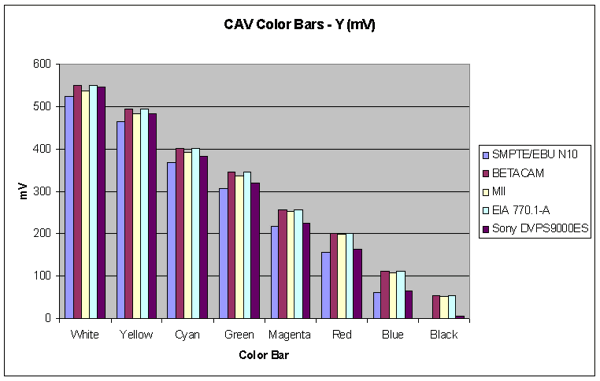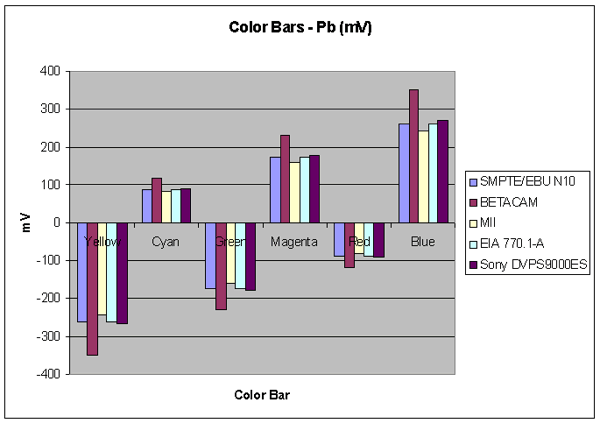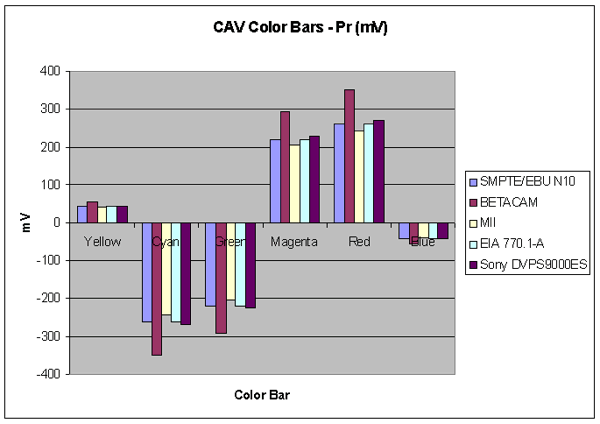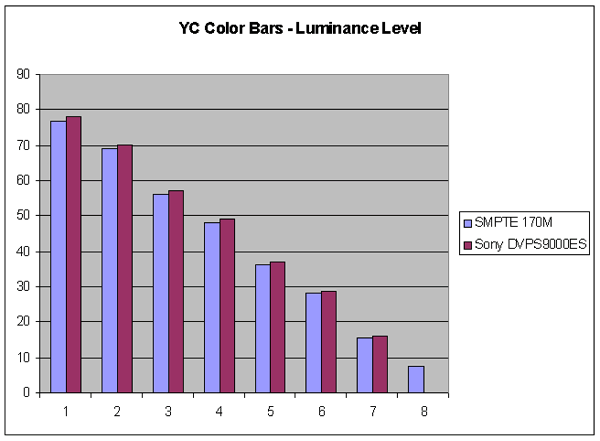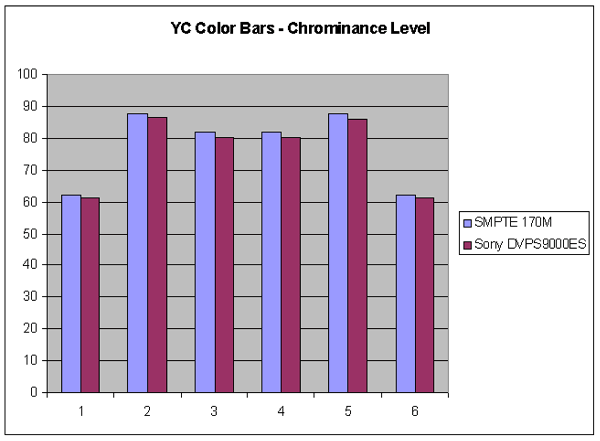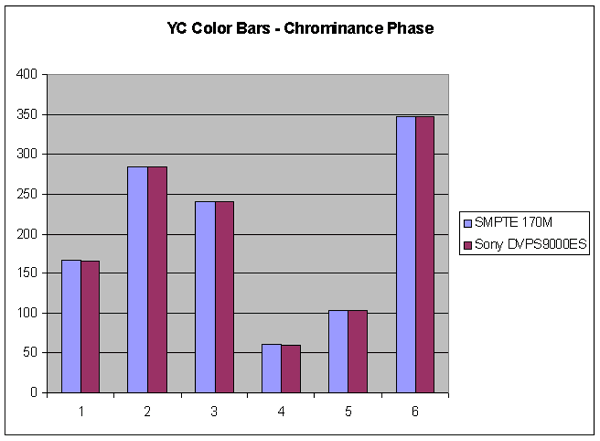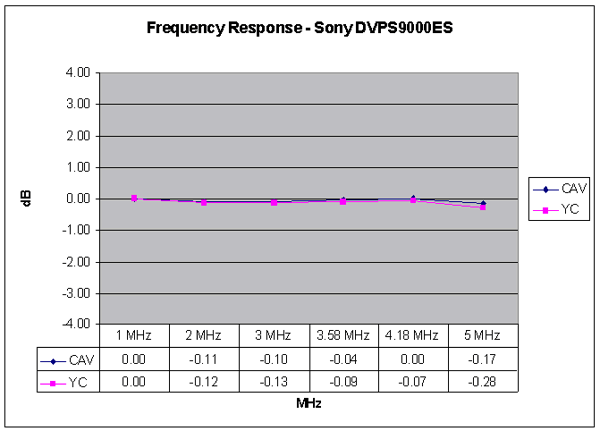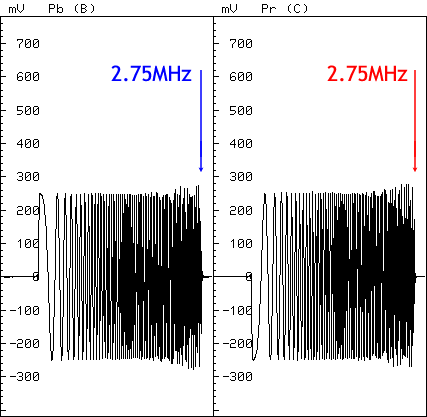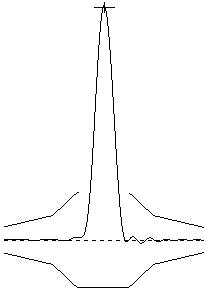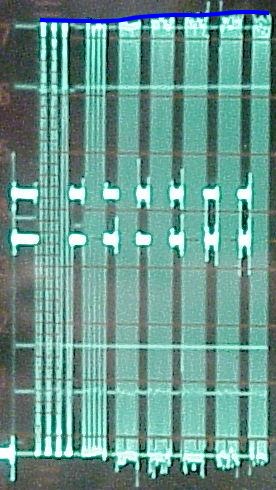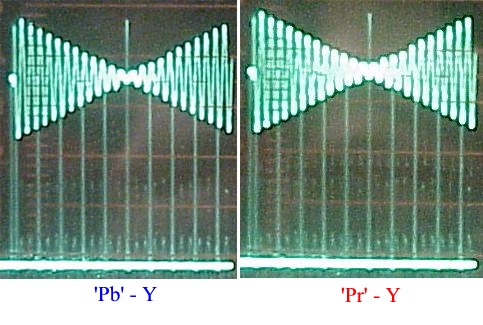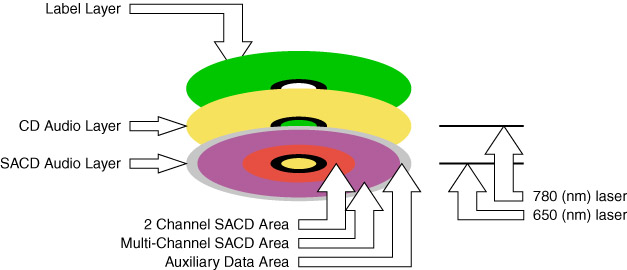DVD Benchmark - Product Review - Sony DVP-S9000ES Progressive DVD-V/SACD player - February, 2001 Staff
Introduction
This is Sony's third generation reference DVD player. At the time of its release, it was also Sony's lowest priced SACD player, so this alone may justify the purchase of the 9000, if you want SACD. It is also Sony's first progressive DVD player. Their white paper hailed it as the greatest de-interlacing technology known to man. In the end it turned out to be just marketing hype (MANY companies are guilty of this) as they use an off-the-shelf chip from Genesis that is merely ok.
Anyway, here are our test results:
Video
All in all, the 9000 offers many improvements over the original Sony DVP-S7000. The 7000 is Still Sony's only reference DVD player that does not have the MPEG chroma bug we discussed in our previous reports. The CAV video outputs are correctly labeled Y'Pb'Pr.
Black and White Levels
Format Black White Comments CAV 7.8 102.1 The black level is just about perfect. White is a hair too hot. YC 7.8 101.8 The YC levels closely match the CAV levels. Color Bars
CAV
The Y out of the CAV channel starts out above MII at white. It then falls below below MII and eventually matches SMPTE levels by the point it reaches blue.
The Pb portion of the CAV output is just above SMPTE and EIA levels. The Pr portion of the CAV output is just above SMPTE and EIA levels.
Component Analog Video Data
YC
The Y level of the YC output is slightly higher than SMPTE 170M, except for black where it is low.
The chroma level is slightly lower than SMPTE 170M. The Chroma phase of the YC output is virtually perfect.
Composite/YC Data
Video Frequency Response
We are including both a luminance and chrominance frequency response, as well as a 2T pulse for the Sony DVD player. We have also included a digital photo of the progressive output frequency response. We made our measurements with the sharpness set to 0. Anything above 0 adds excessive ringing to the image. The sharpness control on the 9000 has a range from 0 to +20!
The interlaced output is the flattest (meaning excellent) that we have ever measured. The progressive outputs peak at the higher frequencies. We believe this is why the progressive outputs have a little ringing compared to the interlaced outputs.
The chroma response is flat out to 2.75MHz. It actually looks like it might begin to peak, but it's ok. The chroma channel should be flat out to 3.375MHz. (our test pattern only goes out to 2.75MHz).
The 2T pulse shows just a small amount of pre-shoot and overshoot. It is very good.
There is ringing on the Avia sharpness pattern. This type of ringing would be more correctly called band elimination ripple. It takes the form of a ghost that exists on both sides of the vertical lines in Avia. These ripples are symmetrical. They exists around the thinnest vertical transitions on the Avia sharpness pattern. There is much less ripple on this DVD player compared to the Pioneer DV-37. This should not show up in actual movies because the high frequency information is often filtered. You will see it (ripple) on DVD menus, the Sony onscreen menus, and the Avia sharpness pattern.
Video Frequency Response
Interlaced - Luminance
Interlaced - Chrominance
Interlaced - 2T
Progressive
Pixel Cropping
We did not get a chance to measure the pixel cropping of this DVD player.
Signal-To-Noise Ratio
Format Output SNR (dB) Comments CAV Y -81.4 Stellar - The lowest we have ever measured. CAV Pb -85.1 Stellar - The lowest we have ever measured. CAV Pr -85.0 Stellar - The lowest we have ever measured. YC C-AM -60.1 Good YC C-PM -57.2 OK Component Channel Timing
We used the Tektronix 1735HD to get a look at the progressive output timing, and we have included a digital photo of the progressive outputs. The interlaced values are listed in the table below.
The channel timing of the progressive output is perfect. This is a textbook example of what it should look like (the highest vertical line is in the dead center of the bow tie). The interlaced outputs are just as good.
Component Channel Timing
Progressive
Channel Timing (ns) Comments 'Pb' to Y 0.9 Stellar 'Pr' to Y 0.7 Stellar 'Pb' to 'Pr' 0.2 Stellar - Stacey Spears -
Audio
How in the world did I end up with this assignment?
Our video editor, Stacey Spears, asked me to provide listening impressions of Sony's hot new piece, the DVP-S9000ES. It took a lot of arm twisting on his part to get me to agree to this but in the end his strong-armed coercion tactics were successful ;->. My listening included more than I'm reporting on, but I have some recordings which I am intimately familiar with . . . my gold standards if you will. They are used in every review I do. However, besides being a review magazine, Secrets also wishes to educate our readership on the technology involved in our home theater and hi-fi hobbies. The beginning of this report is an explanation of some of the technology involved in delivering SACD to the consumer via media and players.
Thanks up front, instead of at the end.
I'd like to take this opportunity to thank a few people at record labels who graciously supplied SACD media for me to use in this review. From Telarc Records, Mike Wilpizeski and Valerie Thorson got me several review samples, some of which are referenced below. Likewise, thanks to Louis Masses at Sony who arranged for several Sony titles to be shipped my way for use in evaluating this player in SACD mode. Lisa Hersch at Chesky Records also arranged for some sample SACD titles, but they did not arrive in time for my inclusion in this review (but I will use them in the next SACD player review, that's for sure).
Sony/Philips and the Concepts behind SACD
As the patents and royalties expire for the original Compact Disc, Sony/Philips, co-inventors of the wildly successful Compact Disc format, were looking for an alternative to continue to provide the lucrative money stream that the original CD provided. Sony had developed a process called Direct Stream Digital (DSD) for archiving their vast library of master tapes. Several years back, Sony purchased Columbia Records, which has one of the largest catalogs of music. Along the way, Sony decided to bring their partner Philips in to make a go with DSD as a consumer reproduction technology, which has since been dubbed the Super Audio Compact Disc (SACD). As such, SACD presents a radical departure from CD audio techniques and deserves explanation.
DSD uses Pulse Width Modulation (PWM) technology, which is fundamentally different from the familiar Pulse Code Modulation (PCM) format that has served us well for compact disc during the last two decades.
Below are primers on the two differing technologies used for SACD vs. Compact Disc/DVD-Audio. They are not intended as technical references, but rather just as a glimpse into the technologies. I highly recommend Ken Pohlmann's book "Principles of Digital Audio" for an in-depth discussion of these technologies.
Pulse Code Modulation Primer
Pulse Code Modulation was first used in our telephone system. It was intended to provide robust data communications while providing sufficient resolution such that people on either end of the conversation could readily comprehend one another.
There are two key parameters in PCM: sampling depth (how many bits you're allocating for various voltages) and sampling rate (how many times per second you will be taking these samples). By choosing samples that are sufficiently close together, our ears can reconstruct the sound from many samples per second. It's sort of like movies. Our brains assemble a smoothly moving image from 24 still pictures shown to us each second. Digital telephony is built on 8 bit / 8 kHz sampling. With 8-bit resolution, 256 voltage values are possible, and these voltages are sampled 8,000 times per second. The problem with these voltage samplings is that each sample is not necessarily 100% accurate. The furthest that any single sample can be from accuracy is 1/2 of the lowest possible encodable value (a.k.a. Least Significant Bit or LSB). Variation of the sampled value from the actual sample is referred to as sampling error. The greater the sampling depth, the less error that is introduced. The goal of digital telephony is not high resolution communications, but rather to provide adequate fidelity for communicating by voice on the telephone.
For the Sony/Philips Compact Disc, a sampling depth of 16 bits, and a sampling rate of 44.1 kHz was selected. This allowed for 65,536 voltages (216), as well as frequencies to approximately 20 kHz, to be recorded successfully. To get into the details of why 20 kHz is the practical upper limit, look at Volume 1 Number 1 here at Secrets to read about Nyquist's Sampling Theorem. At the time, the compact disc was heralded as a great leap forward in sound reproduction compared to the then king, LPs. In a matter of a few years, the country changed over from purchasing LPs to CDs. I recall those days, and how quickly the LP bins were taken over by the CDs. Sony and Philips jointly patented the original CD format, and enjoyed enormous royalties from these patents. Although originally only slated for music, the CD quickly became the medium of choice for Computer Software distribution. Other uses of the CD have come along, but the basics of CD reproduction have remained essentially unchanged.
DVD-Audio, a higher quality potential replacement for the Audio CD allows for higher sampling depths (up to 24-bits) and sampling rates (up to 192 kHz) because of an enormous amount of space on the discs, measured in gigabytes rather than megabytes. DVD-Audio players are becoming widely available as this article is being written. With its higher bit rates and sampling depth availability, the opportunity to vastly surpass the sonic capability of the compact disc is possible. Whether DVD-Audio succeeds in the marketplace is another issue that will be answered over time.
Pulse Width Modulation
I'm not sure who was first responsible for the use of pulse width modulation. It is fundamentally different than PCM. Rather than a relatively small number of high resolution samples (24-bit encoding encompasses 16 million possible voltage values, i.e., 224), PWM relies on a brute force method, substituting a 1 bit sampling depth at incredibly high speed (2.8 MHz is the standard for consumer playback equipment).
Creating the PWM samples involves a simple compare, record, and hold system. At start, the voltage will be zero. At the first sample, the voltage is compared to the previous sample. If the sample has a higher voltage than the previous sample, a 1 is recorded, and the new voltage stored. This process is repeated ad infinitum.
Supposedly, the mastering of PWM discs is at double the delivered rate, i.e., sampled at 5.6 MHz and then down-converted to 2.8 MHz for consumer equipment. I have no way of verifying this claim presently. During reproduction, either full positive voltage (a digital 1) or full negative voltage (a digital 0) is recorded. 0 voltage is created by toggling 1 and 0 bits for an aggregate average of 0v. The effect of these very high speed transitions is that our ear perceives the average of these pulses as the original waveform (more or less).
Were my example picture a little more accurate, you'd notice that the density of pulse trains "on" (numbers) and "off" (blank space) bear a resemblance to the original waveform. Where the slope is high, the density of "on" pulses is higher. As the wave form slope drops (near and at the peaks), the pulses drop off, resulting in a "white space". The advantage of PWM versus PCM is that, due to the extremely high sampling rate, only a simple low-pass filter is necessary. This is in stark contrast to PCM based systems, with lower sampling rates, "Brick-wall" filters, with slopes greater than 100 dB/octave are implemented, next to a very narrow guard band. And, as we all know, filters produce artifacts.
Regardless of the method of reproduction, it's really a sonic illusion. Our ear/brain combination cannot process these individual samples rapidly enough, so our brain interprets these rapid bursts as the average over time of these values. This conveniently works out to the voice at the other end of the telephone line, or your latest high fidelity recording on CD/SACD/DVD-Audio you've just purchased.
As you'll see below, DVD-Audio isn't the only option with Multi-Channel Surround capabilities. Hybrid SACDs will play in any CD or DVD player. My tests on CD players have included a computer CD-ROM drive, an older Pioneer multi-disc CD changer, an inexpensive portable CD player, and two car CD players. None of these players had any difficulties playing back the CD layer of any of the hybrid SACD discs I tested.
In testing DVD players without SACD capability, I used an older Toshiba SD-3108, a new Onkyo DV-939, and a JVC XV-723GD - all of which defaulted down to the CD layer and played them back without incident. This cross-section of players leads me to believe that few, if any, CD or DVD players without SACD capability will have any problems playing back a hybrid SACD disc's CD layer.
Building a disc for all Players
The goal for creating hybrid SACD discs was to allow this disc to be played back not only with a SACD player, but in any CD or DVD player as well. As my above notes indicate, every player that I tested this with selected its appropriate layer for playback, be it CD or SACD. The image below shows the components of each layer of an SACD disc, along with the physical sandwiching of layers within a hybrid SACD disc. The CD layer is a standard Redbook CD layer, with all of its normal properties, including enhanced CDs still possible. I suppose that a Video CD could be included as the CD Layer, but I have no way of testing whether this is truly possible. I'm not sure that this would ever be needed, but one never really knows what ideas people will come up with.
The SACD layer actually contains three discrete regions. Closest to the center of the disc is the two-channel stereo mix for the SACD. DVD-Audio has a single multi-channel (i.e., 5.1) mix with fold down instructions for use in stereo configuration. SACD specifies that a dedicated stereo mix be created. If the recording has a multi-channel mix included, it follows in the next region of the disc, out from the center. Tom Jung's DMP label is supposed to be shipping several multi-channel SACDs at the time of this writing, but I haven't received any of these discs to determine if this is true or not. For that matter, multi-channel SACD players haven't quite hit the market, although the Philips SACD-1000 I saw demonstrated at CEDIA 2000 should have been brought to market by now. I'm not sure if its delays were hardware based, or if the lack of multi-channel media delayed its introduction. The last region of the disc (near the outer edge) has the capability to store additional data, e.g., text graphics or other pertinent data about the disc. Maybe SACD-Enhanced content could be placed there, a la the enhanced CD.
The layers are carefully sandwiched, so that the appropriate wavelength of laser picks up its corresponding data. The 650nm laser used for DVD layers is the layer closest to the bottom surface. The CD layer follows, since the 780nm laser penetrates deeper into the substrate. CD players will not even see the SACD layer on the disc. Standard DVD players, and DVD-Audio players also default down to the CD layer, and I've seen this in action. It is my guess that the SACD layer may contain instructions similar to this: "If unable to read SACD content, refocus to read in 780nm mode to access Redbook CD content."
Sony DVP-S9000ES on Redbook CD material
The DVP-S9000ES has several modes that appeal to the audiophile, one of which is Audio Direct. In this mode, all video circuitry and front panel display circuitry are turned off, as well as the digital output stage. When using digital outputs, the video circuitry and front panel display circuitry can also be turned off.
Here Are the Ground Rules for My Tests:
- Levels matched using RCA SPL meter within 1 dB using the first two bars for each musical selection involved.
- My Subwoofer was physically disconnected from the preamp/processor to eliminate the possibility of its engagement when using digital inputs.
- Main speakers were defined as Large in speaker setup (this is their normal configuration).
- Audio direct engaged for analog listening.
- Video and Front Panel Circuitry were shut off for the players use as a digital transport.
Associated Equipment for Listening Sessions:
- Preamplifier/Processor: B&K Reference 30
- Amplifier: Aragon 8008x3 Balanced
- Speakers: Acoustat Spectra 22 Full Range Electrostatic (-3 dB @ 32Hz)
- Interconnects: Nordost Red Dawn (RCA Termination)
- Speaker Cable: Nordost Red Dawn (Z-plug Termination)
- Power Cables: Shunyata Research Sidewinders to all components
Redbook CD listening:
Bob Mintzer Big Band, Camouflage, Digital Music Products (DMP) CD-456
Bob Mintzer's Big Band has been recording on Tom Jung's label going back at least 12 years. I used his second or third disc for DMP, Camouflage, and so far, it's my personal favorite. This was recorded rather uniquely, with a single point stereo microphone employing a ribbon transducer for all of the horns. The album notes have a shot of the horns circled around the microphone. Talk about a challenge for the recording engineer! The balance was set by the musicians themselves, moving closer to or farther from the microphone. When a player took a solo, he stepped a little closer to the microphone. For the musicians, it was also a bit unusual, since they're used to playing in a stacked arrangement, saxophones, trombones, and trumpets from front to back.
Track one is "Techno Pop", a rhythmically driving number in a Jazz-Rock style. Jazz-Rock is played with an even eighth note pattern as opposed to the swing feeling of the classic Big Band era. It starts off with a hard attack and glissando from the brass, before the saxophones and rhythm section fire off. Midway through, Randy Brecker takes an extended solo, which concludes with Randy playing a "shout chorus" over the band's accompaniment. It includes a section that alternates between soft (piano) sections and loud (mezzo forte to forte).
Analog playback (Using the 900's DACs):
All the instruments blend well, but during the trumpet solo, I find the soloist's tone lacking its characteristic "bite" or "edge" . . . a polite version, as though his bell turned a few degrees to the side. Cymbal work of the drummer is not as crisp and precise as I'm used to hearing. Bass trombone, kick drum, and electric bass are a tad lighter than I'm used to from this track. At times, I found it difficult to follow the electric bass, which sets the harmonic foundation.
There's plenty of warmth in the right places, but some of the minutiae it should contain are missing. My listening notes called this "Fuzzy". Mintzer coaxes a variety of tones from his horn not all of which are reproduced well. During one section of his solo, the brass creates a series of bell-tone chords (from the trombones up through the trumpets, sounded one at a time). The foundation tones tend to be obscured as the additional horns add to the richness of the resulting chord.
Digital playback (Using the DACs in my Receiver):
Mintzer's arrangements use "modern" groupings of instruments where, at times, the trumpets and alto saxes carry a line, the trombones and tenor saxes carry another, with baritone sax and bass trombone contributing yet another. With the Ref 30 as my DAC, I found that the timbral characteristic of the instruments within these groupings was not lost, although the blend was still there. I wrote one further comment, which was very succinct "BETTER BASS".
Track three is the ballad "A Long Time Ago" which features leader Bob Mintzer on Tenor. Even though it's a ballad, it swings, and has some sections which have louder volumes. Instrumental grouping is more traditional, with trumpets, trombones, and saxophones playing together (generally) as sections. It includes another "shout chorus", with Mintzer wailing over the rest of the band. It starts off gently and builds throughout, with a gentle decline from the pieces, peaking to a calm ending. Mintzer's superb tenor chops are displayed throughout his solo work, from delicate tone to sufficient strength to wail over the rest of his band in the shout chorus.
The minutiae are back, as well as the variety of different timbres of the various registers and tones that Mintzer coaxes from his saxophone. My other listening notes simply say "Spot On".
The Grainger Edition Volume 8, Royal Northern College of Music Wind Orchestra, Clark Rundell/Timothy Reynish conductors, Chandos CHAN 9630
In my freshmen year of college (many years ago), I had the opportunity to play on a recording of Percy Grainger's Works, titled The Unknown Grainger. I'm not sure how many copies this sold, but it was on a label (Crest Digital) whose primary market was selling to educational institutions. It was an early digital recording (1982 to be precise), and I won't comment on the sonic qualities. I still have the disc in my collection. Chandos has recorded some of these songs, though not necessarily identical versions, and when I saw it, I scooped up the disc. It's an excellent example of a 16 bit/44.1 kHz recording. I've chosen two tracks from this disc for the tests.
Track five, "The Immovable Do" is conducted by Clark Rundell. The uniqueness of this piece is a high level drone of concert C sounded throughout (hence the title). It's an inventive piece with full dynamic range, and nearly every instrument gets a brief "moment in the sun".
Analog playback:
In some sections, I find problems with differentiation in various instruments. For example, in one section, there is a tutti section with French horns and trombones, and a slight bit of the "edge" from the French horns has disappeared from the sound. Even in the best blended groups, there's always just a slight bit of edge that remains with these instruments playing together. There is also a snippet of alto saxophone which is mildly off in its tonal character, lacking the fullness it should have.
Near the end of the piece, with the entire ensemble playing, the full sound of a wind orchestra comes off a little light in body.
The opening bars feature bassoon, bass clarinet, tenor saxophone, and euphonium in unison, with clarinet in contrapuntal harmony. The unique readiness that the bassoon produces isn't as apparent as it should be within this particular grouping. The clarinet counterpoint is reproduced well however. Whenever a collective of clarinets plays, it's impossible to get each player to sound perfectly identical to the others, and during a unison passage of the melody, some of the richness of a section of clarinets (probably second clarinets, as once again, the first clarinets ride on top with counterpoint) is lost. The good news is that the second clarinets are slightly out of tune on concert A (which is the length of the instrument). This isn't quite as apparent as I've heard it, so that might be a blessing! At the peak of the piece (about the 4:00 minute mark), with the pipe organ in the lowest octave, I miss the authority that should be present. The final chord of the piece should also energize the room with the orchestral chord plus the pipe organ, and does not do so to the level I've heard with just my main speakers.
Digital playback:
Dynamic subtleties, slight variations in attack from a single instrument for example, are rendered more distinctly. A point not mentioned above is that, in one section, French horns and alto saxophones are playing in unison, and have a characteristic sound. These were rendered with appropriate edge (from the French horns) and roundness (from the saxophones). Near the end, the full weight and authority of the wind orchestra seems to have been restored.
Track eight, "Irish Tune from County Derry" is conducted by Timothy Reynish. Almost everyone knows this piece, perhaps as "Danny Boy". In this arrangement, a dark and brooding tone is used. Add to that a pipe organ, which cranks out some prodigious bass (just under 4:00), and you've got a wonderful 6:00 or so of reference material. I focus a lot on the clarinets for this particular arrangement, due to their prominence. At one point, the first clarinets provide counterpoint to the second clarinets playing the familiar melody.
The bassoon sounded more appropriate in the opening bars, and the unique timbre of the clarinet's Clarion register to my ear, came across a bit more accurately. The body of unison clarinets is lusher and more pleasing to my ear. I do however want to find the one player who's just the slightest bit out of tune and pull the bell out just slightly to get that concert A in tune! Just under the 4:00 mark, my listening room was energized with the increased bass presentation from the digital output. In layman's terms, WOW!
Steely Dan, Two Against Nature, Giant Records 9 24719-2
I've been a fan of Steely Dan since the first time I heard "Deacon Blues" as a young saxophonist. Boy did that Tenor solo (by Pete Christlieb from the Tonight Show Band) cook. Their albums have always had superb sonics and Messrs. Becker and Fagan are said to be absolute perfectionists for their released products. After roughly a twenty year hiatus, they finally released a new album, often referred to as 2VN. They followed this up with a concert DVD/Video which included a generous helping of the tunes from their classic library as well as several selections from 2VN. Things I've always loved about "The Dan" are their ability to produce a ferocious groove, the interesting tales they weave lyrically, and complex harmonic structures that are a cut above the average pop fare.
Track two is "What a Shame About Me" a tale about a man whose life hasn't quite worked out the way he expected. It starts with a relaxed four beat groove for the verse, with a double time two-beat feel for the chorus. The bridge resumes a smooth four beat feeling. Walter Becker takes the guitar solo. That's the scoop on this tune.
Analog playback:
The backing vocals have a nice blend, and all the layers that they place into their work are reproduced clearly. While the bass line is obviously there, it seems to favor the higher notes, further up the neck, or off of the D and G strings. The bass drum is a touch softer than I've heard in other places, and the cymbal work is lacking that shimmer you hear from top notch reproduction of this particular tune.
Digital playback:
The opening of this track has some chimes whistling back and forth between channels that is more evident from the digital output than the analog output. Vocal blend is better than before, yet there's more of a hint of the uniqueness of each backing vocalist. The backing vocalists have more depth to their voices - I hadn't noticed a thinness in the analog playback. Cymbals had more distinctness as the different sized platters were struck. Bass on the lower strings had more body around the plucked notes, and the kick drum had more weight to it.
Supertramp, Breakfast in America, A&M Records CD-3708
Supertramp is another pop/rock group that had excellent recording quality (and actual dynamic range). If memory serves me correctly, this was Supertramp's biggest selling album, and I always select one track from this recording. It isn't my favorite track, but it contains some unusual instrumentation for a pop tune. Not a lot of pop tunes use clarinet, trombone, and tuba, but the title cut does.
Analog Playback:
What separates the good from the great sound reproduction is two areas. The first is in the second verse, where a trombone, tuba, and acoustic piano triple a line, with the bass punctuating the end of the line. The next is in the entrance of the clarinet; on less resolving systems, it's easy to confuse the clarinet for a soprano saxophone. On better resolving systems, it's painfully obvious that it's a clarinet, played rather loosely. With analog playback, the clarinet reproduction falls somewhere in between, and it's tough to tell whether it's a clarinet or soprano sax. With the doubled lines on trombone/tuba, the characteristic tone of the tuba is modestly obscured, and it takes on almost a bass trombone quality.
Digital Playback:
The anomalies noted above don't exist. In addition, a snare roll/cymbal crash is more evident in the introduction than with the analog output of the player.
Redbook CD playback conclusions:
Given what's been written above, it would be easy to say that I didn't like the Redbook performance of this player. It was certainly enjoyable, but I found it readily improved with the addition of a better DAC section for Redbook CD audio (i.e., the DACs in my receiver). It is a fine performer, but has areas for improvement that have been documented in my musings above. Since the typical use of this player will be in a system with a higher end preamp/processor or perhaps a high-end receiver, it is quite good as a transport for Redbook CD. With the common thread of my complaints (lack of bass authority, resolving power, and some clarity issues), some would point to my preamp/processor as the culprit. My listening sessions with SACD indicate that this is not the case.
Sony on SACD
Now we're down to the meat of the listening thoughts - how does this player sound on SACD? The snappy one line answer is, "Extremely good". Above, I noted the construction of Hybrid SACD media. Every SACD manufacturer, with the exception of Sony, are shipping hybrid discs. Unfortunately, disc costs are about double that of Redbook CD (between US$25 and US$30). As additional plant capacity and the number of titles increase, I hope that the costs can get down into the ballpark of Redbook CDs. If not, I fear that this format will not have a place in anything but a niche market.
Dave Brubeck, 40th Anniversary Tour of the UK, Telarc CD83340-SA
I chose two standards from this recording, which features altoist Bobby Militello attempting to fill the role of Paul Desmond. The first cut of this disc is "Someday My Prince will Come", and starts with a series of choppy, fat chords from Brubeck's piano. After this intro, the tune lapses into a slow tempo rendition of the chorus, with Brubeck's lush chord voicings he often uses in ballads. When Brubeck drops down to play a single note with his left hand, the roundness of that note is startling. You seem to hear it all. The soundstage is vividly presenting - there's Dave, his right shoulder facing the audience and the piano opening out horizontally toward center stage. The acoustic bass and drums seem to stretch from just to the right of center to dead right. When Militello steps in, humorously quoting the opening bars of "The Mickey Mouse Club" march, he's dead center, with a fat tone from top to bottom of his horn until he steps up into his altissimo register. At times, his tone gets raspy and rough, and at one point he gets into this really hard be-bop mode with particular effectiveness. This recording gets the details correct, with all the variations and subtle nuances that this live performance must have had. Another thing I noticed, is that I've not heard the extreme right hand of the piano keyboard (top of its range) sparkle as true to life as I heard on this SACD.
Next, I listened to a ballad, "Deep Purple", with Brubeck playing a very simple obligatto passage as an introduction, with no sense of meter. When he finally kicks into the main tune, he uses simple voicings, and often hides the melody line within the chords. On this ballad, Militello pays homage to Paul Desmond, with a lush, romantic, and warm sound that hints at the late altoist, without losing his distinct personality. Again he quotes briefly another tune "Stranger In Paradise" - when I heard this quote a wry smile came over my face. Great players are able to get snippet quotations completely within the context of their improvisations. Alec Dankworth's acoustic bass on this track is particularly well done. The sound is very subtly round and full. If you've ever played next to an acoustic bassist, using an excellent amplifier, this is about how it is in real life. It's not romanticized in any way shape or form - merely there in all its acoustic correctness.
For the record, I also listened to the CD layer on this disc on the Sony, and on an Onkyo DV-939, and the sound was lifeless and two dimensional in comparison to the SACD version. If I hadn't heard the SACD, I might have thought that the CD sounded pretty good.
Carole King, Tapestry, Ode/Epic/Legacy ES 65850
With all the demo material I received, there was only one recording with a female vocalist, and this is it:
This is a timeless pop music recordings, with a number of great selections, including some made more famous by other musicians. It includes two bonus cuts, but since it's from Sony, it is not a Hybrid SACD. I used "So Far Away" because it's one that's less talked about, and who really wants to read about "It's Too Late" yet again? Alright, that cut sounds good too! "So Far Away" features Carole's voice: sweet, pure and clear - remarkably well done for a recording coming up on 30 years old. One of the things that stuck out on this, besides the musical cohesion, were the little details. Individual plucks of guitar strings, nicely reproduced reasonably sized drum kits (no 20 piece kit here folks). Strong bass. There's some flute work at times in this selection, and the flutist's tone is wispy and thin. I'm not sure if this is intentional by the flutist or the recording - but that's what you get. This recording is a bit restricted, lacking the openness that more modern recordings have. Strictly from a preservation standpoint if a classic, the work is tremendous.
Yo-Yo Ma, Solo, Sony Classical SS 64114
This track was from a Sony SACD sampler, once again an SACD only disc. "Appalachia Waltz" was the track provided. From the first sounds produced on this track, I got an image of a celloist sitting in my listening room, playing a private concert for me and my wife. Immediacy? You bet! At times, the rich, beautiful resonance of his instrument was filling my room. On softer passages, you could hear the rosin on the bow as it is swept across the strings to produce the beautiful notes. How can this man produce so much wonderful music, all by himself? I have no idea, but wish I had the entire disc to listen in an attempt to figure out just how he does it. To be honest, I'm not a particular fan of solo cello, but this track is making me rethink this very seriously.
And now, another timeless classic, this time in the jazz idiom:
Miles Davis, Kind of Blue, Columbia/Legacy/Columbia Jazz CS 64935
How many copies of this particular disc do we have in our collections? Somewhere around my house, I have an LP. I have two copies on CD, and now this on SACD. Why is that? Because on two dates in 1959, a true jazz masterpiece was created. I always use "So What?" as a benchmark piece. Who would have thought that such great diversity of sound could be produced from a song of only two chords? The structure, A-A-B-A is a very common form in jazz. Each letter denotes a harmonic structure, and usually a melodic one as well. In this case, the A section is simply 8 bars of D minor 7. The B section is 8 bars of Eb minor 7. That's it, that's the chordal structure of the song. Enough music theory, how does this sound?
This is the first time I've really heard the master tape. Paul Chambers' acoustic bass comes through a little clearer on the introduction. Bill Evan's beautiful variations of these simple chords coupled with Chambers' clean walking bass lines makes the harmonic foundation for the uncomplicated structure solid, secure, and a wonderful canvas for the horn players to expand on the construction. Three soloists take their turns, starting with the relaxed simplicity or Miles Davis' improvisation. Next, the furious workings of pentatonic mastery and the sounds of a giant being born (John Coltrane's improvisation). Finally, the blues tinged, deliciously grooved wailing (Cannonball Adderley's improvisation).
I found that John Coltrane's tenor sound was a little warmer than previous memories of this recording, as was Miles Davis' trumpet sound. Cannonball Adderley's alto sound retained its robustness that was his trademark throughout his career.
So what is this recording lacking? Top end sparkle - the cymbals aren't as vivid as modern recordings, and the absolute clarity is missing. This is 40 years old, and I think it's about as good a recording as could be made at that time, plus reviving it after all that time.
I hear the production qualities of some current recordings and wonder, how much have we forgotten about making them sound good in the last 40 years?
Mighty Sam McClain, Blues for the Soul, Telarc Blues CD-83487SA
The people at Telarc know how to make recordings. Make all the arguments you'd like about the content. The production qualities are uniformly excellent. Even their Redbook CD catalogue boasts excellent sonics.
Mighty Sam McClain is a traditional blues artist, and this effort captured by Telarc, is sonically pristine. It is by far the best sounding SACD I received. It's a top-notch performance, by a very tight band.
Sonically, Sam McClains voice is crystal clear and presented with great immediacy. There's just the slightest hint of reverberation in the vocals, but not so much that it's distracting. I haven't heard him perform live, with his voice un-amplified, but I get the feeling it doesn't sound much different than this recording.
The horn section is clean, crisp, and tight, like one person playing four horns simultaneously (wait a minute isn't that Rahsaan Roland Kirk?) Bass is a little heavy, but likely intentional. The drum kit sizzles and sparkles, with snare hits cutting through, laying a solid rhythmic foundation for these guys to groove, groove, groove. In spots, the Hammond B-3 organ sings out, just a bit subtle, to emphasize musical points here and there. The guitarist sneaks in the wah-wah pedal to good effect in a few spots as well.
It was hard for me to take listening notes on this one; I just wanted to sit back and listen to them play.
One last test:
While this is not officially listed on the specs capabilities of this player, I had to test CD-ROM capability. I have a few "Audio" CD-ROMs and used a burned copy successfully on the player. I also burned a conventional data CD-R. This disc loaded, and I was greeted with the friendly message "ERROR" after attempting to read the contents of the disc.
Conclusions:
We've all seen the recent progressive scan shoot-out results in Secrets, but right now, I'm not a huge video nut. Sure, I want a better TV that takes a progressive scan input, but I'm still a music lover at my core.
For Redbook CD, I think you can do better, especially at this price point.
SACD is another story. In my opinion, the sonic quality of SACD exceeds that of 24-bit/96KHz PCM. Having only heard some limited selections in 24-bit/192KHz PCM, I'm not sure how that would fare in a head to head battle.
If Sony were to manufacture this transport, in all its elegant design, as a multi-channel SACD player only, without the video circuitry, I'd buy it. It's that simple.
SACD is the finest digital music reproduction I've had in my home to date.
- John Kotches -
Functionality
Note: A green check in the boxes below means that feature worked OK. A red X means it is unsatisfactory.
Avia
Test Results Comments Subpicture Slide Show Video Essentials
Test Results Comments Blacker-Than-Black Stress Test WHQL
Subpicture Palette (DCS)
Test Results Comments Still Bob Weave Default Palette Color Index
Test Results Comments Still Bob Weave Custom Palette Color Index
Test Results Comments Still Bob Weave Branching
Test Results Comments Seamless Branching The Sony is a bit slower than expected; it takes 3 sweeps. Multiple Angles It takes between 1.75 and 2 seconds to change angles. Menu
Test Results Comments Loops Ends Field/Frame Freeze
Test Results Comments Weave Bob It does not display a valve like it should. You can force it to do so by selecting field pause. 16x9 Menu
Test Results Comments Letterbox Widescreen Cropping
Test Results Comments 352x240 720x480 704x480 352x480 Layer Break
This player was slow; it took about 2 seconds to change layers.
Test (DVD) Results Comments "Cruel Intentions" "Ghostbusters" "Friend" VCD We had to used forced video mode. Otherwise there were severe combing artifacts. "Saving Private Ryan" (DTS) "The Abyss" Chesky Super Audio 96/24 This is user selectable in the menu. Random Number Generator Chroma Upsampling Error This DVD player is using an LSI MPEG decoder. Physical Response
We gave the overall response of this player a 7.
Test Results Comments Setup You can select Setup for the interlaced outputs. The progressive outputs do not have setup. This is the way it should be. Transcode CD-R While people have reported getting a CD-R to work with blue die CD-Rs, it does not work on my old green dye CD-R. Error Correction/Concealment
Pierre Vareny
The audio error correction on CD is near the best in player performance. It was able to handle up to and including chapter 35, which represents a 2.40mm gap. This is great!
Scratch the Dog
It's DVD error correction is not as good as its CD error correction. It dies at chapter 2.
- Stacey Spears -
Usability
We did not perform a usability study on this DVD player.
Progressive
These tests are from the Progressive DVD Shootout. If you want to understand the tests that were performed, you should read Part 5 - Progressive Scan DVD.
The S9000ES is a very good unit, but not absolutely top notch. Our chart shows that the S9000ES didn't do perfectly on our de-interlacing tests, but the chart doesn't tell the whole story. The S9000ES uses the two-chip Genesis solution, which means it uses cadence reading, and the de-interlacing has all the problems of that chipset. However, while the player failed most of the same tests as the other players using the Genesis chipset, it became clear as we were testing that the S9000ES combs less often than the other Genesis-based players, and it combs for a shorter time. You can see this on the “comb count” on "The Big Lebowski".
We think that Sony has tweaked the settings on the Genesis film-detection chip, so it is faster to leave film mode and slower to return to film mode. You can see this in the long recovery times on the Mixed Mode and Chapter Stops tests. This protects against combing, though it does mean the S9000ES is more likely to use video mode, and for a longer time. In practice, most of the time when the S9000ES drops to video mode, you won't notice it. Combing is much more noticeable than switching to video mode, so the Sony engineers made the right choice here.
That said, the Sony clearly didn't come close to the performance of our Silicon Image-based players. Watching some material in Auto mode on the Sony, such as stuff shot on film and edited on video, like "More Tales of the City", is an exercise in frustration, and you'll probably find yourself switching to Video mode. Sadly, the menu to change de-interlacing modes is buried deep, and it takes a lot of button pressing to get there. You have to stop the player to change the mode, though the Sony will remember your place and return there when you hit “Play.”
The S9000ES has the chroma upsampling bug, clearly visible in "Toy Story", though not as bad as some other players. As with the 7700, when you hit pause on the remote, the color problem clears up.
We saw the same flickering and distortion of the left-hand diagonal lines on the Video Essentials Zone Plate pattern, which is consistent with what we saw on the 6200/9200/939.
- Don Munsil -
DVD Benchmark Explanatory Articles Part 3 - Functionality Part 4 - Usability Part 5 - Progressive Scan
© Copyright 2001 Secrets of Home Theater & High Fidelity
Return to Table of Contents for this Issue.

